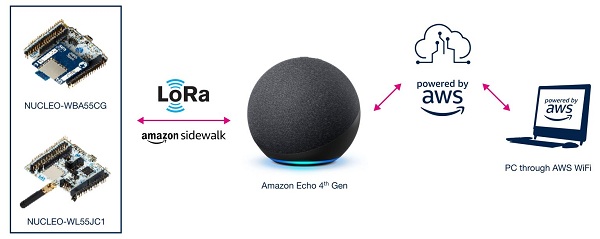
For the first time, Nucleo boards housing an STM32WBA5 and an STM32WLx5 received the Amazon Sidewalk certification, thus guaranteeing these STM32 MCUs will offer robust integration, high efficiency, and trusted security when deployed on an Amazon Sidewalk network. We are even showing how Subeca, an end-to-end water management platform in the United States, leveraged these STM32 devices to obtain its Amazon Sidewalk qualification, thus ensuring its customers can benefit from this vast and secure network to create a cost-effective and scalable solution for water metering and pressure management IoT systems.
What is Amazon Sidewalk?
The idea behind Amazon Sidewalk is elegantly simple: using Internet-connected devices like Amazon Echos or some Ring Floodlight and Spotlight Cams, which serve as Amazon Sidewalk Bridges, to create a low-bandwidth and low-powered wireless network by piggybacking on a tiny amount of the Bridges’ bandwidth (80 Kbps). An Amazon Sidewalk device can thus connect to a Sidewalk Bridge using Bluetooth, securely connecting to its network and benefiting from the Internet. Moreover, once an Amazon Sidewalk end device is provisioned to the network via Bluetooth LE, it can rely on the long-range connectivity of the STM32WL5 to extend the network coverage over vast distances.
Amazon Sidewalk is free to use and simplifies operations. If a Sidewalk Bridge loses its Wi-Fi connection, Amazon’s technology can initiate a reconnection to the router without the user’s intervention. Bandwidth is also very low, and data usage is minimal and capped at 500 MB a month, meaning that even customers with a constrained Internet connection won’t feel its impact. Moreover, Amazon has numerous encryption and secure mechanisms to keep data private and safe. Hence, it’s possible to use Amazon Sidewalk for logistic, personal, or pet tracking, beyond-the-fence asset monitoring, smart irrigation systems, healthcare monitoring, or, as Subeca demonstrates, for more demanding applications like utilities monitoring on a national scale, as the Sidewalk coverage map suggests.

What the Amazon Sidewalk qualification means for STM32 developers
The hardware
As of today, boards featuring the STM32WBA5, STM32WL5, and STM32WLE5 have received the Amazon Sidewalk qualification. The STM32WBA5 offers a Cortex-M33, a Bluetooth LE 5.4 transceiver, and can target a SESIP Level 3 certification, while the STM32WLx5 devices use a Cortex-M4 and a sub-GHz radio. Engineers might choose an STM32WBA55 and an STM32WLE5 to optimize memory usage or an STM32WBA55 and an STM32WL55 for the greater flexibility this configuration affords.
Concretely, the STM32WBA5 talks directly to the Amazon Sidewalk Bridge using a Bluetooth LE connection. And in some instances, that’s all the system needs. However, when networking multiple end nodes over large distances, like in the case of Subeca, it’s necessary to use the STM32WL5 to talk to devices using CSS (Chirp Spread Spectrum, such as LoRa) or an FSK modulation, depending on the distance and frequency range engineers wish to target.

The software
To help developers jumpstart their projects, ST is offering software packages that help implement a network stack that easily interacts with Amazon Sidewalk. This dramatically simplifies the connection to the network, the integration of security features into the application, and the onboarding process. Put simply, while an Amazon Sidewalk guarantees that ST devices will provide the reliability and safety required, it is also a testament to our partnership with Amazon and our desire to help engineers take advantage of this technology.

Real-world applications
The qualification and partnership between Amazon and ST means that partners like Subeca can focus on showcasing their expertise and distinguishing their products from the competition instead of spending resources solving networking challenges. As Patrick Keaney, CEO of Subeca, explained,
“Our focus is on innovating and simplifying solutions that solve real-world challenges in the water market. We believe technology like advanced metering, leak detection, and pressure monitoring should be available to all water utilities everywhere, regardless of size. That means wireless connectivity is a must. ST’s STM32WBA5 and STM32WL5/STM32WLE5 wireless microcontrollers enabled us to bring our first Amazon sidewalk-qualified products to the market with great architectural flexibility, performance, low-power consumption in a cost-effective manner with meaningful device longevity and robust and resilient supply chain. Leveraging ST’s expansive device portfolio and ecosystem coupled with great technical support, ST offered us quality technical ingredients, ease-of-use, and portability required to transform our vision into reality.”

Avnet also showcased an Amazon Sidewalk demo at AWS Re:Invent 2024 featuring an STM32WBA5, an STM32WL55, and Avnet’s IoTConnect platform to handle the onboarding, device management, and data integration with AWS. AVnet’s solution is often a darling at ST Technology Tours because it vastly simplifies the creation of IoT systems by handling some of the most complex development operations. Put simply, the demo is one of the best examples of how ST, Amazon Sidewalk, and a member of the ST Partner Program can come together to make a difference in the operations of a company trying to take part in the IoT revolution.
Why it matters?
Interconnecting a myriad of small devices to each other and the Internet has always been the IoT dream. The challenge is that building a new infrastructure from scratch is expensive, and without massive adoption, it will never reach critical mass. Amazon Sidewalk solves this issue by utilizing existing Echo devices and other Bridges connected to a router. By simply leveraging existing installations, the network is already in place. And by enabling product makers and customers to use it for free, it significantly lowers the barrier to entry.
Additionally, Amazon Sidewalk handles a lot of the complexities associated with such a network, from security to over-the-air updates. That’s why Amazon instituted a qualification program. To protect all participants in this ecosystem, Amazon authorizes devices to connect to its network. It also explains the company’s certification program. By qualifying STM32 microcontrollers, Amazon ensures that its partners use trusted devices that will run the network stack reliably and implement security features according to strict standards.






